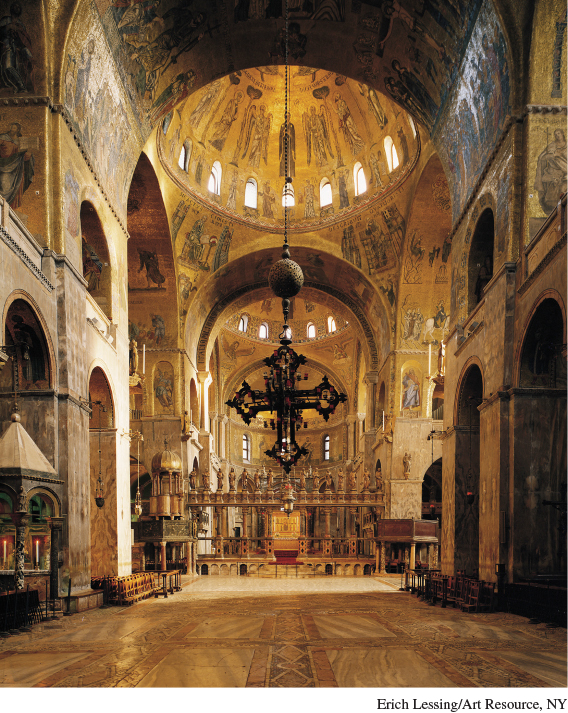The Byzantine Church and Christian Divergence
AP® EXAM TIP
You should know examples of connections between governments and religions throughout history, such as those described here.
Intimately tied to the state was the Church, a relationship that became known as caesaropapism. Unlike in Western Europe, where the Roman Catholic Church maintained some degree of independence from political authorities, in Byzantium the emperor assumed something of the role of both “Caesar,” as head of state, and the pope, as head of the Church. Thus he appointed the patriarch, or leader, of the Orthodox Church; sometimes made decisions about doctrine; called church councils into session; and generally treated the Church as a government department. “The [Empire] and the church have a great unity and community,” declared a twelfth-
Guided Reading Question
▪COMPARISON
How did Eastern Orthodox Christianity differ from Roman Catholicism?
AP® EXAM TIP
Understand the causes of the split within the Christian Church into Latin (Roman) Christianity and Eastern (Orthodox) Christianity in the eleventh century.
Eastern Orthodox Christianity had a pervasive influence on every aspect of Byzantine life. It legitimated the supreme and absolute authority of the emperor, for he was a God-
419
In its early centuries and beyond, the Christian movement was rent by theological controversy and political division. Followers of Arius, an Egyptian priest, held that Jesus had been created by God the Father rather than living eternally with him. Nestorius, the fifth-century bishop of Constantinople, argued that Mary had given birth only to the human Jesus, who then became the “temple” of God. This view, defined as heretical in the Western Christian world, predominated in a separate Persian Church, which spread its views to India, China, and Arabia.
But the most lasting and deepest division within the Christian world occurred as Eastern Orthodoxy came to define itself against an emerging Latin Christianity centered on papal Rome. Both had derived, of course, from the growth of Christianity in the Roman Empire and therefore had much in common — the teachings of Jesus; the Bible; the sacraments; a church hierarchy of patriarchs, bishops, and priests; a missionary impulse; and intolerance toward other religions. Despite these shared features, any sense of a single widespread Christian community was increasingly replaced by an awareness of difference, competition, and outright hostility that even a common fear of Islam could not overcome. In part, this growing religious divergence reflected the political separation and rivalry between the Byzantine Empire and the emerging kingdoms of Western Europe. As the growth of Islam in the seventh century submerged earlier centers of Christianity in the Middle East and North Africa, Constantinople and Rome alone remained as alternative hubs of the Church. But they were now in different states that competed with each other for territory and for the right to claim the legacy of imperial Rome.
Beyond such political differences were those of language and culture. Although Latin remained the language of the Church and of elite communication in the West, it was abandoned in the Byzantine Empire in favor of Greek, which remained the basis for Byzantine education. More than in the West, Byzantine thinkers sought to formulate Christian doctrine in terms of Greek philosophical concepts.

AP® EXAM TIP
Be prepared to give examples of religious influence on architecture.
Differences in theology and church practice likewise widened the gulf between Orthodoxy and Catholicism, despite agreement on fundamental doctrines. Disagreements about the nature of the Trinity, the source of the Holy Spirit, original sin, and the relative importance of faith and reason gave rise to much controversy. So too, for a time, did the Byzantine efforts to prohibit the use of icons, popular paintings of saints and biblical scenes, usually painted on small wooden panels. Other more modest differences also occasioned mutual misunderstanding and disdain. Priests in the West shaved and, after 1050 or so, were supposed to remain celibate, while those in Byzantium allowed their beards to grow long and were permitted to marry. Orthodox ritual called for using bread leavened with yeast in the Communion, but Catholics used unleavened bread. Far more significant was the question of authority. Eastern Orthodox leaders sharply rejected the growing claims of Roman popes to be the sole and final authority for all Christians everywhere.
420
This rift in the world of Christendom grew gradually from the seventh century on, punctuated by various efforts to bridge the mounting divide between the Western and Eastern branches of the Church. A sign of this continuing deterioration occurred in 1054 when representatives of both churches mutually excommunicated each other, declaring in effect that those in the opposing tradition were not true Christians. The Crusades, launched in 1095 by the Catholic pope against the forces of Islam, made things worse. Western Crusaders, passing through the Byzantine Empire on their way to the Middle East, engaged in frequent conflict with local people and thus deepened the distrust between them. From the Western viewpoint, Orthodox practices were “blasphemous, even heretical.” One Western observer of the Second Crusade noted that the Greeks “were judged not to be Christians and the Franks [French] considered killing them a matter of no importance.”10 During the Fourth Crusade in 1204, Western forces seized and looted Constantinople and ruled Byzantium for the next half century. Their brutality only confirmed Byzantine views of their Roman Catholic despoilers as nothing more than barbarians. According to one Byzantine account, “They sacked the sacred places and trampled on divine things … they tore children from their mothers … and they defiled virgins in the holy chapels, fearing neither God’s anger nor man’s vengeance.”11 After this, the rupture in the world of Christendom proved irreparable.